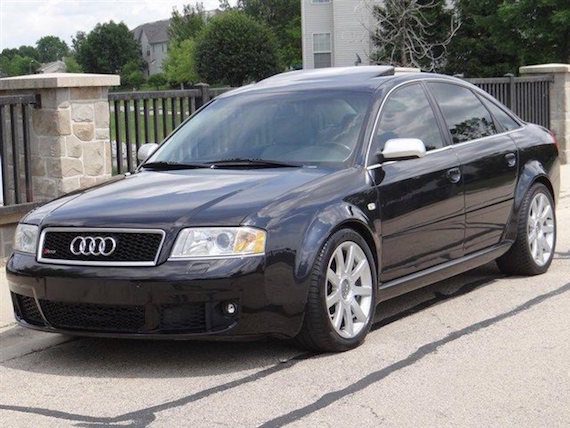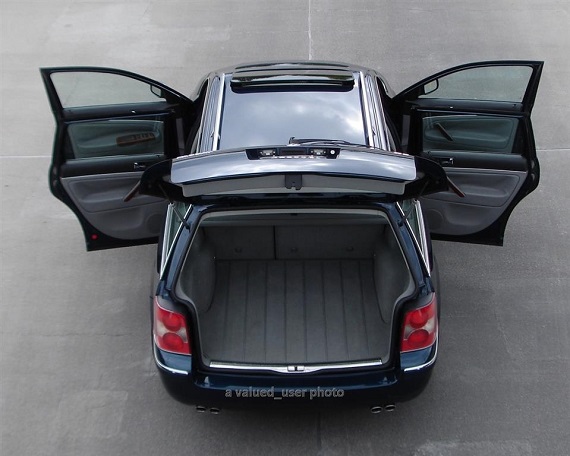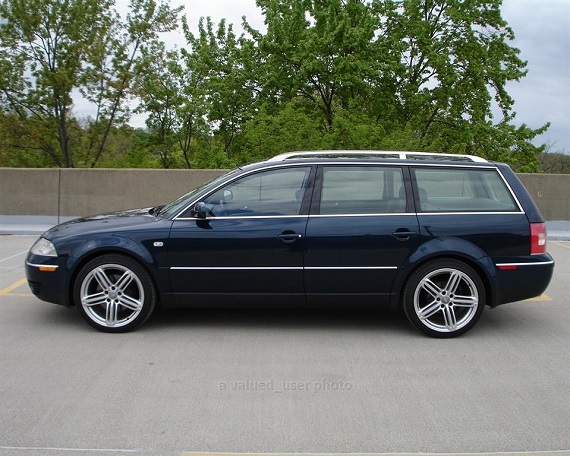For me, the great appeal of the early ’00s era super sedans has always been their relatively restrained styling. Unlike contemporary offerings from M, AMG and quattro GmbH, which are nakedly aggressive and loud, the cars from this period don’t look too different from the underlying models on which they were based. The RS6 is a good example. The C5 platform A6 underpinning the car typifies Audi styling of the time: good looking and functional but a bit staid. I’d be willing to admit that some of the Bauhaus-esque curves and lines give it a little edginess, especially when when viewed from the rear quarter panel, but you have to squint hard to see them. Indeed, Regular Car Review Guy has a bit about the styling of the A4 of the same era being “the future by way of the past,” and I think that the same could equally be said about the A6. This conservatism continues into the RS6, but the deeper front spoiler, flared fenders, 18″ wheels and double exhaust make for a far more muscular look and hint at the extraordinary power that lies beneath. While enthusiasts will know what it is, most other people will mistake it for an ordinary executive saloon. And that’s a good thing. There’s something seriously cool about a car that blends into the crowd, but is nonetheless capable of cracking nearly 200 MPH on the autobahn.
Tag: 2003
Volkswagen is really great at theory, but not so much at execution. They’ve had a long line of really strange marketing decisions which have at times left the company in dire straights. One wonders how Volkswagen will emerge in the wake of the recent diesel scandal, for example, though many other manufacturers like Mitsubishi (you forgot they still made cars, didn’t you? Me too.) are doing their best to usurp VW’s crown as a manufacturing pariah. Yet, Volkswagen has so many debacles it has run its customers through that it should be amazing they come back for more at all. In the early 1990s, they mis-rated the timing belt service intervals on the early V8 quattros. The result was, predictably, a bunch of engine replacements. The 1.8T became notorious for turbo sludge problems, too – rectified with larger filters and synthetic-only oil, but a fair number (including my Passat) had factory turbo replacement. The 3.0 V6? A timebomb of metal shards working their way from the passenger rear of the motor through the engine, thanks to what appears to be an oil starvation design flaw. The 2.7Ts, 4.2s and all of the FSi motors? Known issues, sometimes very large and expensive. Coil packs, unnecessarily complicated PSV systems, transmissions made of glass and clogging sunroof channels? All the norm in your VAG experience. But Volkswagen really outdid themselves by making a complicated system even more complicated when they introduced the 4.0 W8 into the Passat. Sure, it was a test bed for later W12 models, and viewed in that light it makes some sense. But then, the Passat shown here is much more rare than the Bentleys and even some of the A8 W12 models that derived experience from the B5.5. Volkswagen could simply have taken any one of their proven engines and provided the answer to whatever question they were posing when they conceived this vehicle. Instead, they did things differently. That’s both something to celebrate and something to point out as an inherent character flaw:
CLICK FOR DETAILS: 2003 Volkswagen Passat W8 4Motion Variant on eBay
13 CommentsAfter taking a peek yesterday at that miserly Volkswagen Lupo 3L, the thought crossed my mind as to what other interesting models might have existed in the Lupo range. I had a vague recollection there was a GTI version, but I couldn’t remember if it were a concept or indeed a series production car. Sure enough, Volkswagen put a Lupo GTI into production during a time when the original GTI, the Golf, became bloated and started losing its edge. This Lupo GTI was much more in the spirit of the Mk1 Golf GTI, taking a small hatchback and wedging a large four cylinder under the hood, this time in the form of a 1.6 liter lump producing 123 horsepower. This was enough to launch the Lupo GTI from 0-60 mph in under 8 seconds.
For those fortunate enough to live outside of the US and Canadian marketplaces, you can buy a Polo GTI nowadays. However, that Polo is a bit larger than the Lupo GTI, echoing the footprint more along the lines of a Mk2 Golf. I’m still waiting for VW to announce an Up! GTI, but until then, check out this low mileage Lupo GTI for sale near Frankfurt, Germany.
CLICK FOR DETAILS: 2003 Volkswagen Lupo GTI on Mobile.de
Comments closedIf last week’s GT2 RS took insanity beyond what you consider reasonable, then the 996 GT2 may reign in the craziness just enough to be sensible. It also comes with a far lower price tag. Like all things 996 the performance per dollar quotient of these machines is spectacular and matched by few other cars, even when looking at one of the highest priced models in the line. With 456 hp directed only to the rear wheels and around 200 fewer pounds to move around the GT2 returns a level of ferocity and purity to the Turbo’s driving experience that had been gradually softened over the model’s life. Though it was no longer necessary for Porsche to produce such a car in order to meet homologation requirements, they still followed a track-focused mantra for GT2 production that forces the driver to remain attuned to every aspect of the car’s current state. It’s as if the rawness of the original 930 had returned, but with a lot more power! We don’t see many GT2s come up for sale so they always attract our notice when they do. This particular example is especially rare: a Lapis Blue 2003 Porsche 911 GT2 with Black leather interior and 48,812 miles on it. The seller has said this is the only example he’s seen in this color, and my experience is the same. There are plenty of Black, Silver, and Guards Red examples. There even seem to be a good deal in Speed Yellow. This is this only one I’ve seen in Blue.
2 Comments







